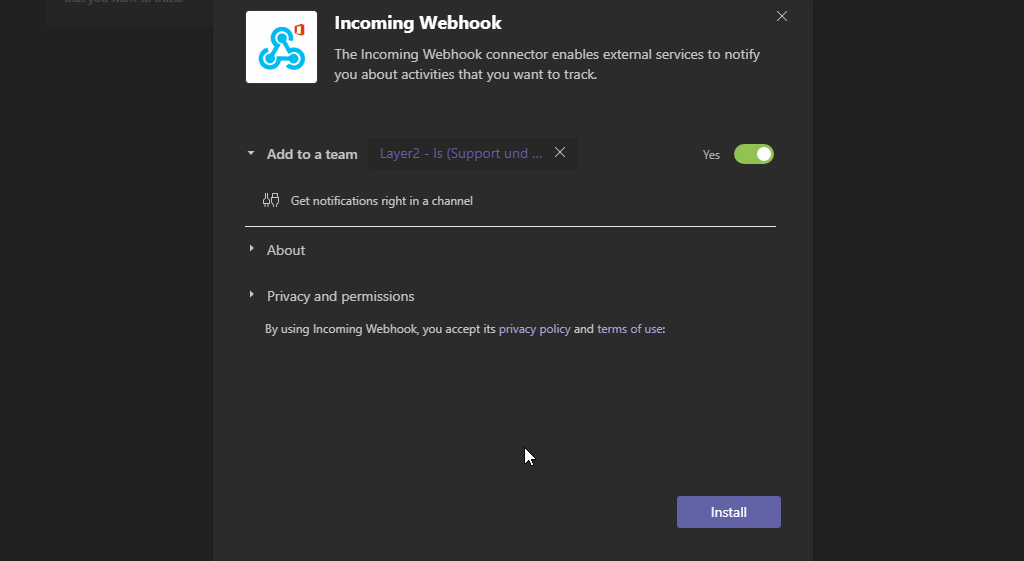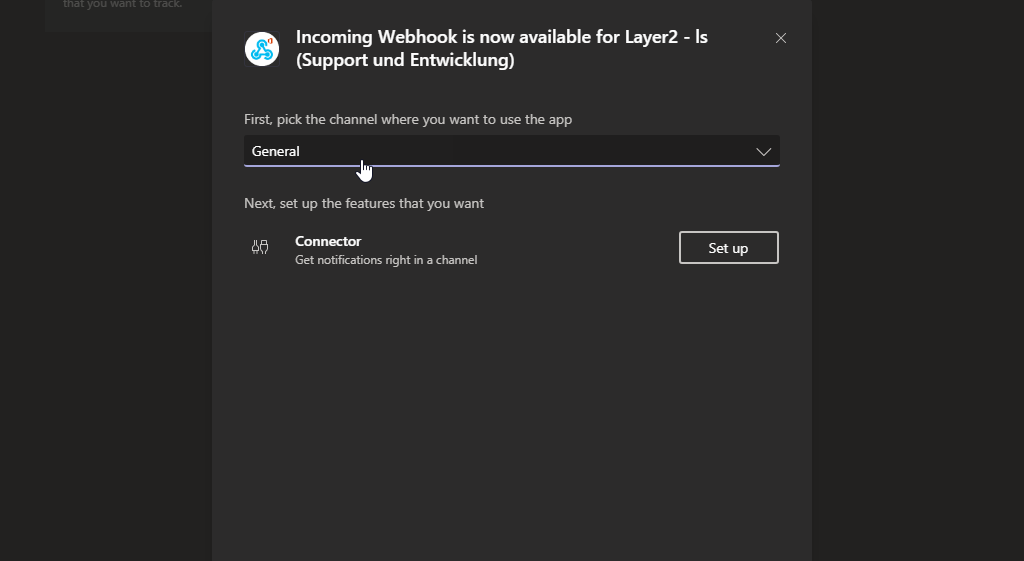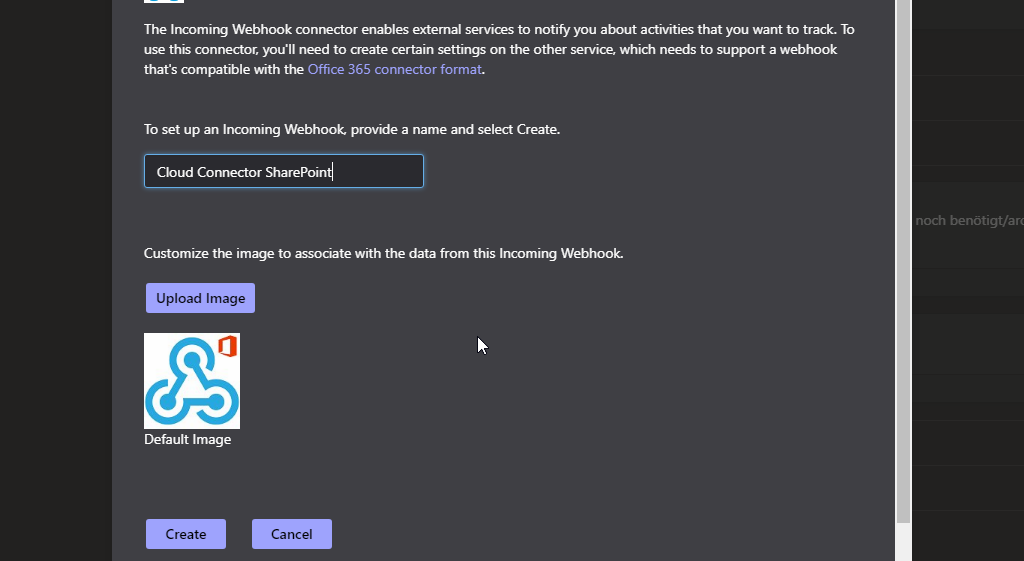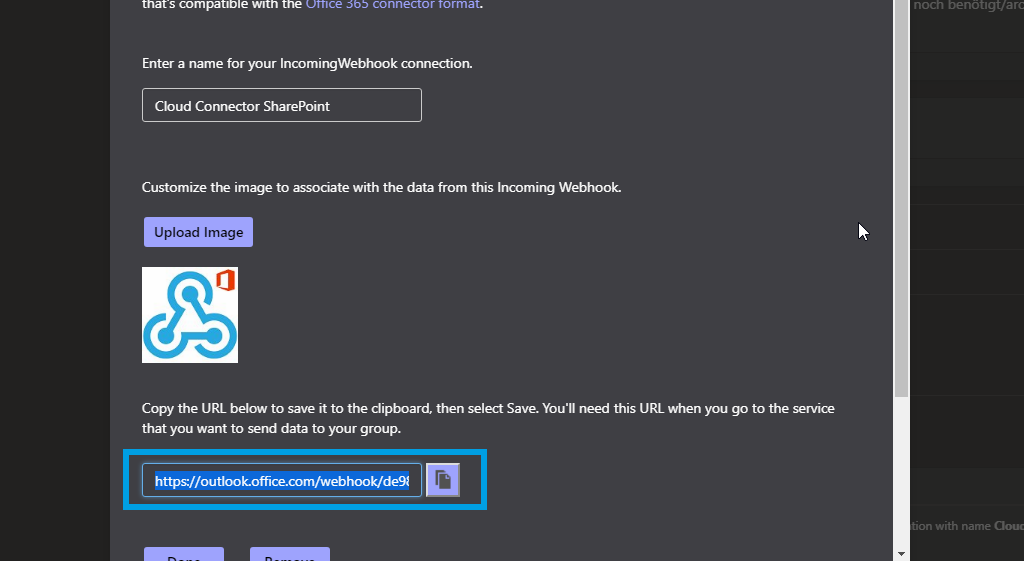Contact us directly to discuss your specific requirements, help you with purchasing, or with any other questions.
This "how-to-connect" documentation
This guide presupposes that you
2. Configuring the Layer2 Cloud Connector
2.2 Configuring the Data Entity 1
2.3 Configuring the Data Entity 2
In order to successfully connect to Microsoft Teams through the Layer2 Cloud
Go to Microsoft Teams App Store and search for the Incoming Webhook Connector.

Install the connector by selecting your Team and your Channel to connect to.


Name the Incoming Webhook Connector. The name will be shown as Notification sender in your Team Channel.

Copy the Webhook URL. You will need it later during the connection configuration of your Microsoft Teams data entity.

Create a new connection by using the Create New Connection option in the Actions pane (right-hand side). The new connection will appear at the bottom of the Connection Manager List (left-hand side). Click on your newly created connection to open the connection configuration settings.
Choose a meaningful name for your connection and replace the current "New Connection" Connection Title with it.
An initial connection should always be uni-directional to assure that both data entities are identical before switching to bi-directional. Therefore, choose Left to Right as Direction.
-connection-setup.png?sfvrsn=5e2a9f81_2)
We will now set up our Data Entities. Go to the data entity “Data Entity 1” to open the configuration settings.
Choose a Data Entity Title. It is recommended to give your entities meaningful names to maintain an overview when you decide to set up multiple connections.
Select the Data Provider for SharePoint from the data provider list. You can search for SharePoint by typing into the selection box.
For more information about the SharePoint provider visit:
https://www.layer2solutions.com/support/cloud-connector-faqs/layer2-csom-sharepoint-ado-net-provider.
-integration-source-setup.png?sfvrsn=4f2a9f81_2)
Create a custom SharePoint list or select an existing list from which to display the data in Microsoft Teams and copy its URL.
-integration-connection-string-setup.png?sfvrsn=2d2a9f81_2)
You can copy the below Connection String which contains the minimum of required properties to connect to your custom SharePoint Online list.
URL=https://your_sharepoint_list_url/AllItems.aspx;Authentication=Office365;User=user@domain.de;
Use the Verify Connection String option to evaluate if the provided connection string is valid.
Enter the user account's password into the Password field. The field masks the value for better security.
Set your primary key field.
To check if all necessary columns are received, you can use the Preview Data option on the right-hand pane which will provide you with a pop-up window showing your sample data from your SharePoint entity.
-integration.png?sfvrsn=512a9f81_2)
We are going to send the data to a channel in Microsoft Teams.
Use the left-hand pane to switch to the data entity "Data Entity 2". We will be using the Layer2 Teams Provider for this setup.
For the Connection String, we need
WebhookURL=https://outlook.office.com/webhook/a28023ab-.....-ac8a-bb540d856d4e;
The Select Statement should point to the columns from SharePoint you want to retrieve data from. In our case, we are sending the information in the column Title to Microsoft Teams.
-integration-target-setup.png?sfvrsn=202a9f81_2)
In the next step, we will configure our mapping settings. Click on the Mappings option on the left-hand pane. If your fields from SharePoint are named identical to the fields from your source system, the Enable Auto Mapping option will match those columns. Disabling this option allows you to match your columns as needed. We enabled auto-mapping in our setup. Save your changes by using the right-hand pane option Save Changes.
-integration-mapping.png?sfvrsn=5b2a9f81_2)
To run your connection switch back to the main connection configuration node and use the Run Now Button located on the bottom of the setup page. The Run Synchronization Toolbox will also display the synchronization process.
-data-integration-start.png?sfvrsn=372a9f81_2)
Below is a data preview of the information we have
-integration-ready.png?sfvrsn=2a2a9f81_2)
This will be the result in our Microsoft Teams
-integration.png?sfvrsn=542a9f81_2)
From now on, changes of the Title field in your SharePoint list will be synchronized with your selected channel in Microsoft Teams.
As far as tested, this connection supports uni-directional only.